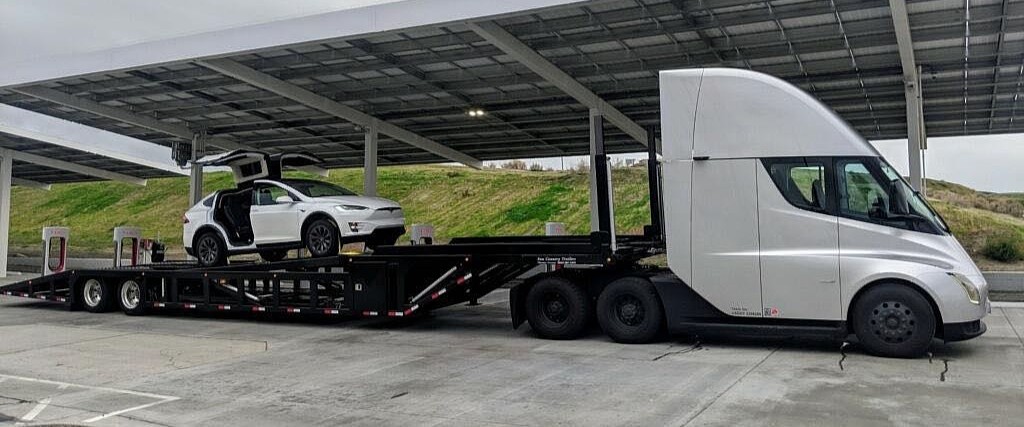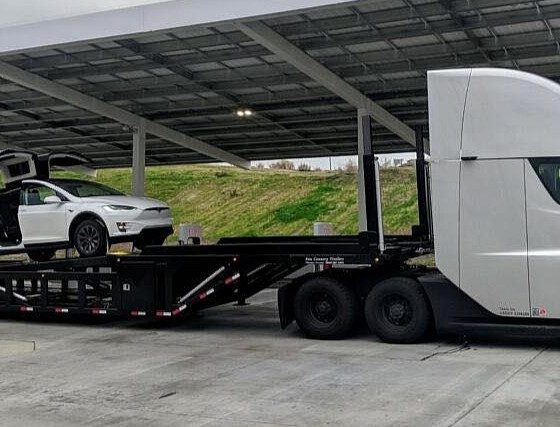

News
Tesla Semi with Model X in tow is an “aircraft carrier”, teases Jerome Guillen
In a rather rare social media post, Jerome Guillen, Tesla’s President of Automotive, shared an image of a vehicle that truly lies close to his heart — the Tesla Semi. The Automotive President’s post features the all-electric long-hauler parked at a Supercharger while pulling a trailer loaded with a Tesla Model X. Jerome even cleverly captioned his image with the words “Aircraft Carrier?” — a fun reference to the electric SUV’s open Falcon Wing Doors.
The recently-shared picture of the Tesla Semi was taken at the Kettleman City Supercharger, a site located between San Francisco and Los Angeles. The location is one of the United States’ largest Superchargers with 40 charging stalls, solar panel-equipped roofs, and a comfortable lounge for travelers stopping over to charge their vehicles. The site is also the same Supercharger where the red Tesla Semi prototype was sighted a few weeks back.
Since becoming Tesla’s President of Automotive last September, Guillen’s uploads of the all-electric long-hauler have become rather elusive. That said, his recently uploaded Tesla Semi post was certainly worth the wait, since the image could very well be the first picture of the upcoming electric truck with a completely new cargo and trailer.

The Tesla Semi is expected to be a vehicle that can disrupt the trucking market in the same way that the Model S and Model 3 are disrupting the full-size and mid-size sedan segments. The vehicle incited a lot of raised eyebrows when it was initially announced by CEO Elon Musk, thanks to its impressive specs that include a 300 to 500-mile range, a 0-60 mph time of 5 seconds flat, and four Model 3-derived electric motors. So disruptive were the Semi’s specs that Daimler Trucks boss Martin Daum infamously suggested that the Tesla Semi must be breaking the laws of physics.
Despite these reservations from critics though, the development of the Semi continued. Elon Musk has noted that improvements to the Semi are actively being done, even suggesting that the long-range variant of the all-electric truck could have closer to 600 miles of range per charge. Just recently, even the Daimler Trucks CEO, who dismissed the Semi in the past, acknowledged Tesla and the company’s tenacity. Daum still gave Tesla some warning about the lucrative and competitive trucking segment, though, stating that the business is far trickier than the consumer vehicle market.
“Tesla has proved they really have the tenacity to really go through huge losses to capture the market. But trucking is a difficult business. They will learn the hard way; trucking is not like passenger cars where one size fits all,” he said.
Inasmuch as Daum’s warnings are justified, the Tesla Semi is being developed with steady, experienced hands. Jerome Guillen, after all, has extensive experience in the trucking industry, and prior to his promotion as President of Automotive, he was personally heading the Semi program. Before to his employment at Tesla, Jerome served as the project leader for Daimler’s Freightliner Cascadia program as well, where he eventually became the head of the company’s Business Innovation unit. By the time he left for the electric car maker, Daimler’s Business Innovation unit was profitable and self-funding.
During the vehicle’s unveiling, Elon Musk noted that initial production of the vehicle will commence in 2019. That said, Eric Markowitz & Dan Crowley of Worm Capital stated in a note published after a tour of Gigafactory 1 that the electric car maker is planning on “earnestly” producing the Semi by 2020.

News
Man credits Grok AI with saving his life after ER missed near-ruptured appendix
The AI flagged some of the man’s symptoms and urged him to return to the ER immediately and demand a CT scan.

A 49-year-old man has stated that xAI’s Grok ended up saving his life when the large language model identified a near-ruptured appendix that his first ER visit dismissed as acid reflux.
After being sent home from the ER, the man asked Grok to analyze his symptoms. The AI flagged some of the man’s symptoms and urged him to return immediately and demand a CT scan. The scan confirmed that something far worse than acid reflux was indeed going on.
Grok spotted what a doctor missed
In a post on Reddit, u/Tykjen noted that for 24 hours straight, he had a constant “razor-blade-level” abdominal pain that forced him into a fetal position. He had no fever or visible signs. He went to the ER, where a doctor pressed his soft belly, prescribed acid blockers, and sent him home.
The acid blockers didn’t work, and the man’s pain remained intense. He then decided to open a year-long chat he had with Grok and listed every detail that he was experiencing. The AI responded quickly. “Grok immediately flagged perforated ulcer or atypical appendicitis, told me the exact red-flag pattern I was describing, and basically said “go back right now and ask for a CT,” the man wrote in his post.
He copied Grok’s reasoning, returned to the ER, and insisted on the scan. The CT scan ultimately showed an inflamed appendix on the verge of rupture. Six hours later, the appendix was out. The man said the pain has completely vanished, and he woke up laughing under anesthesia. He was discharged the next day.
How a late-night conversation with Grok got me to demand the CT scan that saved my life from a ruptured appendix (December 2025)
byu/Tykjen ingrok
AI doctors could very well be welcomed
In the replies to his Reddit post, u/Tykjen further explained that he specifically avoided telling doctors that Grok, an AI, suggested he get a CT scan. “I did not tell them on the second visit that Grok recommended the CT scan. I had to lie. I told them my sister who’s a nurse told me to ask for the scan,” the man wrote.
One commenter noted that the use of AI in medicine will likely be welcomed, stating that “If AI could take doctors’ jobs one day, I will be happy. Doctors just don’t care anymore. It’s all a paycheck.” The Redditor replied with, “Sadly yes. That is what it felt like after the first visit. And the following night could have been my last.”
Elon Musk has been very optimistic about the potential of robots like Tesla Optimus in the medical field. Provided that they are able to achieve human-level articulation in their hands, and Tesla is able to bring down their cost through mass manufacturing, the era of AI-powered medical care could very well be closer than expected.
News
Tesla expands Model 3 lineup in Europe with most affordable variant yet
The Model 3 Standard still delivers more than 300 miles of range, potentially making it an attractive option for budget-conscious buyers.

Tesla has introduced a lower-priced Model 3 variant in Europe, expanding the lineup just two months after the vehicle’s U.S. debut. The Model 3 Standard still delivers more than 300 miles (480 km) of range, potentially making it an attractive option for budget-conscious buyers.
Tesla’s pricing strategy
The Model 3 Standard arrives as Tesla contends with declining registrations in several countries across Europe, where sales have not fully offset shifting consumer preferences. Many buyers have turned to options such as Volkswagen’s ID.3 and BYD’s Atto 3, both of which have benefited from aggressive pricing.
By removing select premium finishes and features, Tesla positioned the new Model 3 Standard as an “ultra-low cost of ownership” option of its all-electric sedan. Pricing comes in at €37,970 in Germany, NOK 330,056 in Norway, and SEK 449,990 in Sweden, depending on market. This places the Model 3 Standard well below the “premium” Model 3 trim, which starts at €45,970 in Germany.
Deliveries for the Standard model are expected to begin in the first quarter of 2026, giving Tesla an entry-level foothold in a segment that’s increasingly defined by sub-€40,000 offerings.
Tesla’s affordable vehicle push
The low-cost Model 3 follows October’s launch of a similarly positioned Model Y variant, signaling a broader shift in Tesla’s product strategy. While CEO Elon Musk has moved the company toward AI-driven initiatives such as robotaxis and humanoid robots, lower-priced vehicles remain necessary to support the company’s revenue in the near term.
Reports have indicated that Tesla previously abandoned plans for an all-new $25,000 EV, with the company opting to create cheaper versions of existing platforms instead. Analysts have flagged possible cannibalization of higher-margin models, but the move aims to counter an influx of aggressively priced entrants from China and Europe, many of which sell below $30,000. With the new Model 3 Standard, Tesla is reinforcing its volume strategy in Europe’s increasingly competitive EV landscape.
News
Tesla FSD (Supervised) stuns Germany’s biggest car magazine
FSD Supervised recognized construction zones, braked early for pedestrians, and yielded politely on narrow streets.

Tesla’s upcoming FSD Supervised system, set for a European debut pending regulatory approval, is showing notably refined behavior in real-world testing, including construction zones, pedestrian detection, and lane changes, as per a recent demonstration ride in Berlin.
While the system still required driver oversight, its smooth braking, steering, and decision-making illustrated how far Tesla’s driver-assistance technology has advanced ahead of a potential 2026 rollout.
FSD’s maturity in dense city driving
During the Berlin test ride with Auto Bild, Germany’s largest automotive publication, a Tesla Model 3 running FSD handled complex traffic with minimal intervention, autonomously managing braking, acceleration, steering, and overtaking up to 140 km/h. It recognized construction zones, braked early for pedestrians, and yielded politely on narrow streets.
Only one manual override was required when the system misread a converted one-way route, an example, Tesla stated, of the continuous learning baked into its vision-based architecture.
Robin Hornig of Auto Bild summed up his experience with FSD Supervised with a glowing review of the system. As per the reporter, FSD Supervised already exceeds humans with its all-around vision. “Tesla FSD Supervised sees more than I do. It doesn’t get distracted and never gets tired. I like to think I’m a good driver, but I can’t match this system’s all-around vision. It’s at its best when both work together: my experience and the Tesla’s constant attention,” the journalist wrote.
Tesla FSD in Europe
FSD Supervised is still a driver-assistance system rather than autonomous driving. Still, Auto Bild noted that Tesla’s 360-degree camera suite, constant monitoring, and high computing power mark a sizable leap from earlier iterations. Already active in the U.S., China, and several other regions, the system is currently navigating Europe’s approval pipeline. Tesla has applied for an exemption in the Netherlands, aiming to launch the feature through a free software update as early as February 2026.
What Tesla demonstrated in Berlin mirrors capabilities already common in China and the U.S., where rival automakers have rolled out hands-free or city-navigation systems. Europe, however, remains behind due to a stricter certification environment, though Tesla is currently hard at work pushing for FSD Supervised’s approval in several countries in the region.








